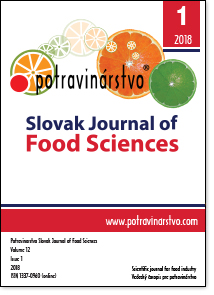Influence of milk thistle pressed parts on rats liver histology
DOI:
https://doi.org/10.5219/864Keywords:
Silybum marianum, histology, growth performance, silymarinAbstract
Milk thistle (Silybum marianum) is one of the best known and very often used herbs with positive effect on liver. The aim of this article was to study influence of addition of milk thistle pressed parts in feed ration on liver histology and weight increase of laboratory rats. The experiment was tested by 15 pieces of laboratory rats divided into 3 groups (A, B, C). The rats in first group (A) hade feed ration with addition of 10% milk thistle pressed parts, second group (B) hade feed ration with 20% and control group (C) hade feed ration without addition of milk thistle pressed parts. The silymarin content of pressed milk thistle seed was 26.2 mg/g. The aim of this article is to study influence of addition of milk thistle pressed parts in feed ration on liver histology and weight increase of laboratory rats. The hypothesis is that the feeding addition - milk thistle seed pressed parts has positive effect on weight performance and liver histology. Does the feeding addition have any effect on these health indicators? Does feeding of milk thistle seed pressed parts have any sense? In results, the groups with addition of milk thistle had significant bigger average gain increases than the control group. Histological results vary considerably among groups of rats. All rats in the control group had dystrophic liver with sinusoidal congestion. In most rats of the group A, the dystrophy was minimal without congestion. On the other hand, most of rats of the group B had liver dystrophy caused by large droplets steatosis with congestion. All rats in control group C were found to have significant dystrophy caused by steatosis. The results indicate rats receiving the addition of milk thistle pressed parts in their feed had a lower incidence of liver steatosis due to the hepatoprotective effects of silymarin.
Downloads
Metrics
References
Abenavoli, L., Aviello, G., Capasso, R., Milic, N., Capasso, F. 2011. Milk thistle for treatment of nonalcoholic fatty liver disease. Hepatitis Monthly, vol. 11, no. 3, p. 173-177.
Andrzejewska, J., Martinelli, T., Sadowska, K. 2015. Silybum marianum: non-medical exploitation of the species. Annals of Applied Biology, vol. 167, no. 3, p. 285-297. https://doi.org/10.1111/aab.12232 DOI: https://doi.org/10.1111/aab.12232
Blevins, S., Siegel, P. B., Blodgett, D. J., Ehrich, M., Saunders, G. K., Lewis, R. M. 2010. Effects of silymarin on gossypol toxicosis in divergent lines of chickens. Poultry Science, vol. 89, no. 9, p. 1878-1886. https://doi.org/10.3382/ps.2010-00768 PMid:20709972 DOI: https://doi.org/10.3382/ps.2010-00768
Dhiman, R. K., Chawla, Y. K. 2005. Herbal medicines for liver diseases. Digestive Diseases and Sciences, vol. 50, no. 10, p. 1807-1812. https://doi.org/10.1007/s10620-005-2942-9 PMid:16187178 DOI: https://doi.org/10.1007/s10620-005-2942-9
Cullere, M., Zotte, A. D., Celia, C., Renteria-Monterrubio, A. L., Gerencser, Z., Szendro, Z., Kovacs, M., Kachlek, M. L., Matics, Z. 2016. Effect of Silybummarianum herb on the productive performance, carcass traits and meat quality of growing rabbits. Livestock Science, vol. 194, p. 31-36. https://doi.org/10.1016/j.livsci.2016.10.012 DOI: https://doi.org/10.1016/j.livsci.2016.10.012
Feng, B., Meng, R., Huang, B., Shen, S., Bi, Y., Zhu, D. 2016. Silymarin alleviates hepatic oxidative stress and protects against metabolic disorders in high-fat diet-fed mice. Free Radical Research, vol. 50, no. 3, p. 314-327. https://doi.org/10.3109/10715762.2015.1116689 PMid:26758315 DOI: https://doi.org/10.3109/10715762.2015.1116689
Guo, Y., Wang, S., Wang, Y., Zhu, T. 2016. Silymarin improved diet-induced liver damage and insulin resistance by decreasing inflammation in mice. Pharmaceutical Biology, vol. 54, no. 12, p. 2995-3000. https://doi.org/10.1080/13880209.2016.1199042 PMid:27387273 DOI: https://doi.org/10.1080/13880209.2016.1199042
Jacobs, B. P., Dennehy, C., Ramirez, G., Sapp, J., Lawrence, V. A. 2002. Milk thistle for treatment of liver disease: A systematic review and meta-analysis. American Journal of Medicine, vol. 113, no. 6, p. 506-515. https://doi.org/10.1016/S0002-9343(02)01244-5 DOI: https://doi.org/10.1016/S0002-9343(02)01244-5
Jakubcova, Z., Horky P., Dostalova, L., Sochor, J., Tomaskova, L., Baron, M., Kalhotka, L., Zeman, L. 2015. Study of antioxidant and antimicrobial properties of grapevine seeds, grape and rosehip pressings. Potravinarstvo, vol. 9. no. 1, p. 382-387. https://doi.org/10.5219/503 DOI: https://doi.org/10.5219/503
Kosina, P., Dokoupilova, A., Janda, K., Sladkova, K., Siberova, P., Pivodova, V., Ulrichova, J. 2017. Effect of Silybummarianum fruit constituents on the health status of rabbits repeated 42-day fattening experiment. Animal Feed Science and Technology, vol. 223, p. 128-140. https://doi.org/10.1016/j.anifeedsci.2016.11.013 DOI: https://doi.org/10.1016/j.anifeedsci.2016.11.013
Loguercio, C., Andreone, P., Brisc, C., Brisc, M. C., Bugianesi, E., Chiaramonte, M., Cursaro, C., Danila, M., De Sio, I., Floreani, A. 2012. Silybin combined with phosphatidylcholine and vitamin E in patients with nonalcoholic fatty liver disease: A randomized controlled trial. Free Radical Biology and Medicine, vol. 52, no. 9, p. 1658-1665. https://doi.org/10.1016/j.freeradbiomed.2012.02.008 PMid:22343419 DOI: https://doi.org/10.1016/j.freeradbiomed.2012.02.008
Tedesco, D., Domeneghini, C., Sciannimanico, D., Tameni, M., Steidler, S., Galletti, S. 2004. Silymarin, a possible hepatoprotector in dairy cows: Biochemical and histological observations. Journal of Veterinary Medicine Series A-Physiology Pathology Clinical Medicine, vol. 51, no. 2, p. 85-89. https://doi.org/10.1111/j.1439-0442.2004.00603.x PMid:15153078 DOI: https://doi.org/10.1111/j.1439-0442.2004.00603.x
Zhu, X. X., Ding, Y. H., Wu, Y., Qian, L. Y., Zhou, H., He, Q. 2016. Silibinin: a potential old drug for cancer therapy. Expert Review of Clinical Pharmacology, vol. 9, no. 10, p. 1323-1330. https://doi.org/10.1080/17512433.2016.1208563 PMid:27362364 DOI: https://doi.org/10.1080/17512433.2016.1208563
Downloads
Published
How to Cite
Issue
Section
License
This license permits non-commercial re-use, distribution, and reproduction in any medium, provided the original work is properly cited, and is not altered, transformed, or built upon in any way.






























